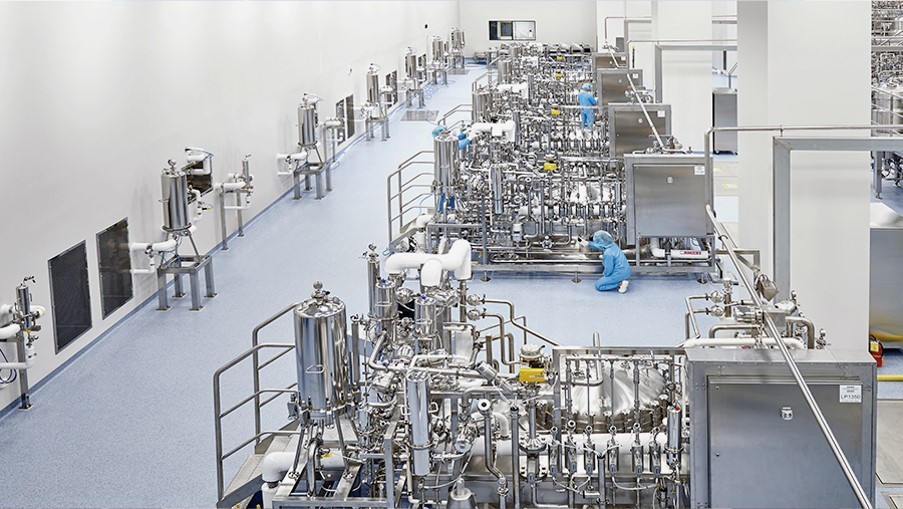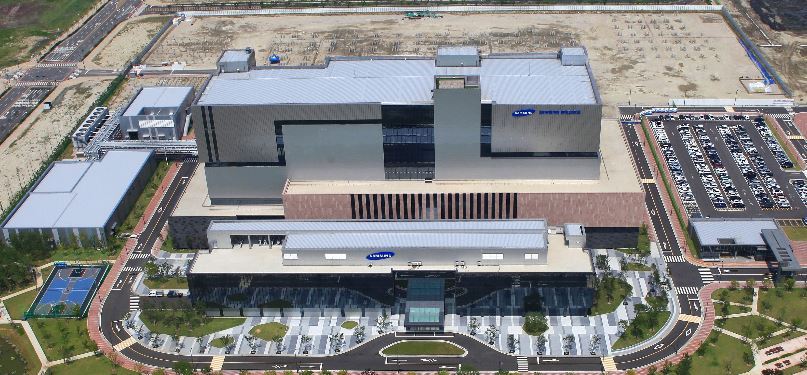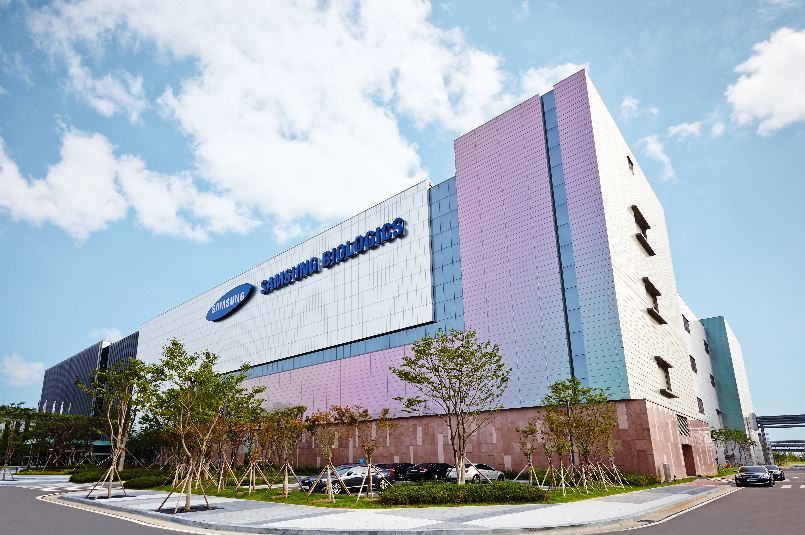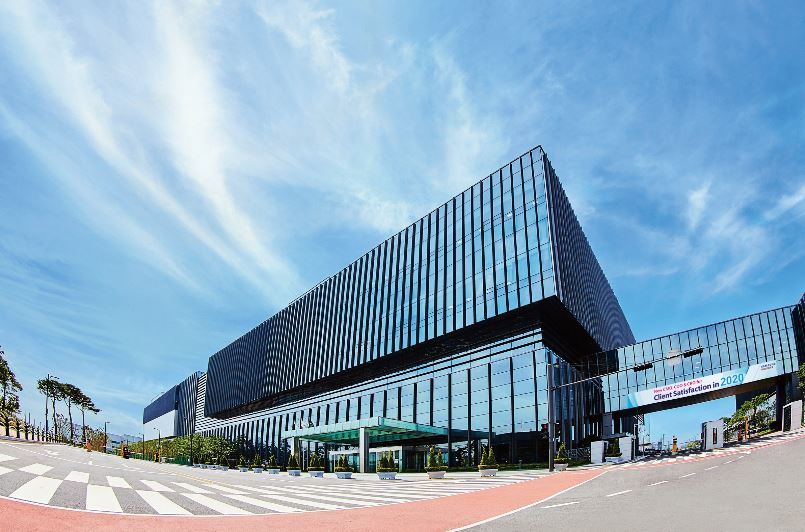[From the Scene] Inside the world’s biggest biologics plant
Samsung Biologics plans another plant ‘in the near future’
By Lim Jeong-yeoPublished : Aug. 3, 2020 - 20:39

This article was written after a one-on-one tour of Samsung Biologics’ plants. -- Ed.
If this era insists that there be “photos or it didn’t happen,” then this trip to Samsung Biologics’ plants may as well have not taken place.
All Samsung plants are under strict security protocols, meaning phones only pass the security gate once tape is placed over both the front and rear cameras. There is also no Wi-Fi for visitors.
So, since no selfies and no candid videos can be taken inside the world’s largest biologics manufacturing site in Songdo, Incheon, South Korea, here’s what stood out at the plant, described in text.
Samsung Biologics has the world’s largest capacity to manufacture mammalian biological substances. Its three plants have a combined output of 364,000 liters in a single generation.
The first plant has six 5,000-liter bioreactors; the second plant has 10 15,000-liter bioreactors and four 1,000-liter bioreactors; and the third plant has 12 15,000-liter bioreactors.
The variance of the bioreactor sizes matters, because they are relevant to the type of contracts the company can win, in terms of their capability to meet clients’ requests for diverse batch sizes. Large commercial manufacturing deals use the bigger bioreactors, while smaller, clinical-stage contract development deals use 1,000-liter bioreactors.
In recent months, Samsung Biologics had been buoyed by the sudden demand from global biopharmas developing COVID-19 treatments. These global houses wanted to be prepared to mass-produce new therapies in the event of a successful candidate emerging.
Having bagged six CMO deals, seven CDO deals and one CRO deal in the three months between April and June, Samsung Biologics clocked record earnings in the first half of 2020.
In a second-quarter report filed in July, Samsung Biologics said it was actively reviewing whether to construct a long-awaited fourth plant in Songdo, Incheon, next to its existing plants, to meet the growing global demand.
If this era insists that there be “photos or it didn’t happen,” then this trip to Samsung Biologics’ plants may as well have not taken place.
All Samsung plants are under strict security protocols, meaning phones only pass the security gate once tape is placed over both the front and rear cameras. There is also no Wi-Fi for visitors.
So, since no selfies and no candid videos can be taken inside the world’s largest biologics manufacturing site in Songdo, Incheon, South Korea, here’s what stood out at the plant, described in text.
Samsung Biologics has the world’s largest capacity to manufacture mammalian biological substances. Its three plants have a combined output of 364,000 liters in a single generation.
The first plant has six 5,000-liter bioreactors; the second plant has 10 15,000-liter bioreactors and four 1,000-liter bioreactors; and the third plant has 12 15,000-liter bioreactors.
The variance of the bioreactor sizes matters, because they are relevant to the type of contracts the company can win, in terms of their capability to meet clients’ requests for diverse batch sizes. Large commercial manufacturing deals use the bigger bioreactors, while smaller, clinical-stage contract development deals use 1,000-liter bioreactors.
In recent months, Samsung Biologics had been buoyed by the sudden demand from global biopharmas developing COVID-19 treatments. These global houses wanted to be prepared to mass-produce new therapies in the event of a successful candidate emerging.
Having bagged six CMO deals, seven CDO deals and one CRO deal in the three months between April and June, Samsung Biologics clocked record earnings in the first half of 2020.
In a second-quarter report filed in July, Samsung Biologics said it was actively reviewing whether to construct a long-awaited fourth plant in Songdo, Incheon, next to its existing plants, to meet the growing global demand.



Inside Samsung Biologics, casually dressed youths walk the hallways in twos and threes, chatting and carrying documents or scientific instruments. It could easily be a university campus.
The average age of the staff at Samsung Biologics is early 30s, which the company explains is due to the industry itself being young in Korea.
As of May 2020, Samsung Biologics had 553 male researchers and 545 female researchers. Altogether, including the processing departments and supporting departments, the company has around 1,560 male employees and 990 female employees. On average, they tend to stay with the company for about three years.
There is a certain global appeal in the atmosphere that hangs around Samsung Biologics. Many of the company’s higher-up officials have overseas backgrounds -- either they come from abroad or were educated there.
Those in managerial positions responsible for supervising the plants often come from an established global biopharma. It is these personnel that are key to Samsung Biologics’ expertise in biologics contract manufacturing and developing -- the field the conglomerate entered less than a decade ago in 2011.
According to Samsung Biologics, these global brains, having spent a significant portion of their careers at larger global pharmas, arrive at Samsung Biologics and are often astounded by the facilities and how advanced they are.
This is where the company’s position as part of Samsung Group comes into focus.
As Korea’s biggest conglomerate and a world-leading semiconductor producer, Samsung is an experienced factory builder for intricate technologies. It has built 25 semiconductor plants and over 50 petrochemical plants, whose functions and characteristics are similar to those of biologics plants.
Just like a semiconductor plant, a biologics plant has to be aseptic, and both kinds of plant use large amounts of liquid in the manufacturing process. And both rely on pipelines that are bent at angles to prevent liquids from pooling.
Samsung’s deep understanding of how to build cutting-edge plants doesn’t stop there -- it also builds them at uncanny speeds. Samsung Biologics makes it a point of pride that it only took three years to build its first plant and four years each for the bigger second and third plants.
The third plant, especially, is a state-of-the-art facility. It not only has the biggest capacity among the three but is also equipped with N-1 Perfusion technology, which enables higher cell concentrations in one bioreactor by removing waste from the tank to free up space so the cells have room to grow.
The big guns in Europe have been in the business for several decades longer than Samsung Biologics, but during that time, their plants have aged.
There have been regular enhancements and expansions, but additions and subtractions cannot compare with a brand-new facility built with cutting-edge materials from the blueprint stage.
It’s also difficult to tear down a plant and build an upgraded one in its place, because the existing facility is needed to fulfill existing client orders.
Samsung Biologics has that advantage of being in Korea, where many things are still affordable compared with Europe or North America.
As time passes, Samsung Biologics will not be exempt from the problem of aging facilities, or the need to diversify the manufacturing lines within its plants.
Samsung Biologics recently announced plans to expand its drug product services by adding two more lyophilizers -- freeze-drying machines -- to the second plant, to be operational from the first half of 2022. The company is also adding flexible filling line by the latter half of 2021, to produce more end products in cartridges, vials and syringes.
This is an effort to bolster the company’s portfolio from a focus on drug substances -- the active ingredients in a drug -- to one that includes more packaged drug products, Samsung Biologics explained.
Samsung Biologics has plans to expand its presence to the wider globe. COVID-19 has stalled the original plan somewhat; however, the company is establishing a contract development laboratory in the San Francisco Bay Area to accommodate the needs of a growing number of innovative biotech companies in the region.
Once that CDO lab is completed, it will reach out to more locations in the US, and then in Europe, and finally in China.
Currently, Samsung Biologics operates only from Songdo.
Samsung Biologics’ biggest competitors are Lonza, a Switzerland-based global CDMO that has a 120-year history, and WuXi Biologics, a Chinese CMO founded in 2014 that is on a formidable growth spurt.
Lonza said in June 2019 that it would invest in a major expansion of its capacity for highly potent active pharmaceutical ingredients in Visp, Switzerland. The company had expected to build two 4,000-liter-scale production lines by July 2020.
WuXi, characterized by its use of disposable, single-use bioreactors, which tend to produce smaller batches than stainless steel bioreactors, plans to grow its drug substance capacity to 280,000 liters by 2022.
Being associated with an electronics company in Samsung Group, there are cross-industrial advantages at Samsung Biologics. One such example would be virtual reality glasses that take visitors closer to the clean rooms, where no outsider access is normally granted. This is an unexpected technological provision in the pharmaceutical industry, which surprises clients, Samsung Biologics said.
Without the VR glasses, one can still look through the clear glass wall at the bioreactors.
Not everything is digitized at Samsung Biologics, however. In one corner is a vast space set aside to store original paperwork for the US Food and Drug Administration and other drug authorities. Samsung Biologics says the data is undergoing digitalization, but the sheer amount of it will require time.
By Lim Jeong-yeo (kaylalim@heraldcorp.com)






![[KH Explains] How should Korea adjust its trade defenses against Chinese EVs?](http://res.heraldm.com/phpwas/restmb_idxmake.php?idx=644&simg=/content/image/2024/04/15/20240415050562_0.jpg&u=20240415144419)











![[Today’s K-pop] Stray Kids to return soon: report](http://res.heraldm.com/phpwas/restmb_idxmake.php?idx=642&simg=/content/image/2024/04/16/20240416050713_0.jpg&u=)